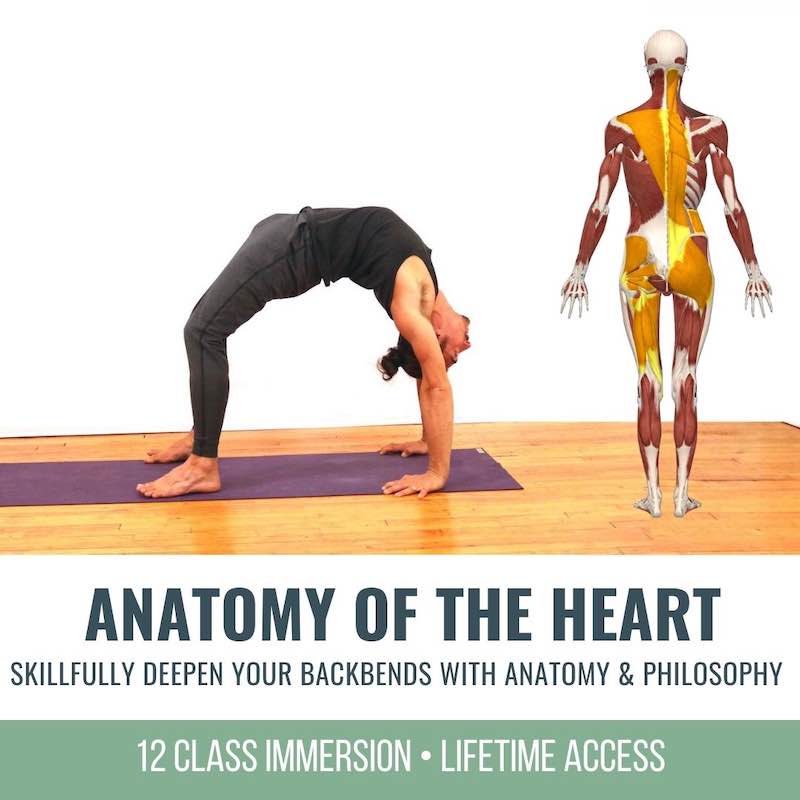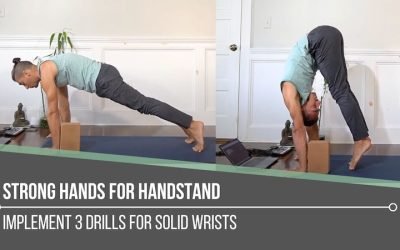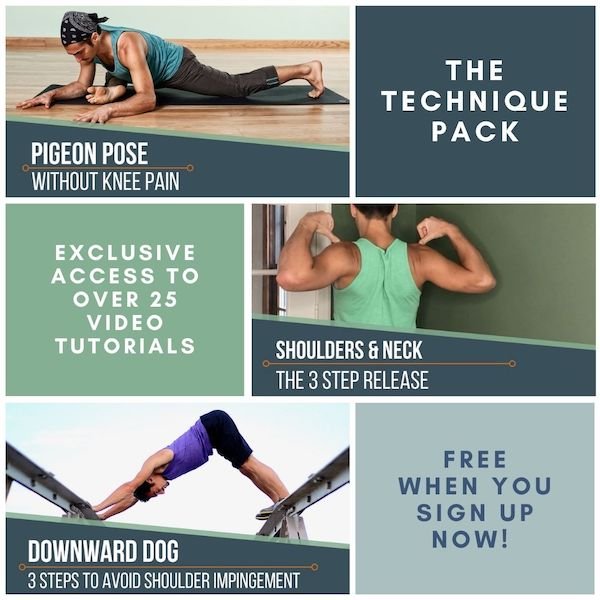BOW POSE—WHERE TO BREATHE
YOGA ANATOMY • BIOMECHANICS • TECHNIQUE
BOW POSE
The Challenge of breathing in backbends
Ever feel short of breath in a backbend? You aren’t the only one. Where to breathe in a backbend is a popular question, and rightfully so. If you look at the anatomy of it, the front-body (anterior) muscles are all stretched out, and the back-body (posterior) muscles are completely contracted. Without getting too technically specific, whenever we inhale, the muscles that surround the abdomen and chest stretch and expand. In a backbend, or heart opener, these muscles are already stretched to their maximum, so there is little to no room to breathe, especially in the belly/abdominal area. Over time, you can certainly increase the flexibility of your abdominals; however, you will likely also begin to deepen your backbends, which will put you right back in the same predicament of fully stretched belly muscles and no additional room for breath. On the flip side, the back muscles are completely contracted and shortened. All of the vertebrae of your spine are in extension, making it very hard to breathe in the back body with so much contraction.
ANATOMY OF THE HEART
JUNE 2022 Immersion
- Technique to expand and deepen your backbends
- Foundations and preparatory postures to set you up for success
- Anatomy education to prime the nervous system
- Themes to cultivate the appropriate mindset for heart opening
- 12 Classes: 6 focused on anatomy, 6 themed for the heart
- Unlock a wide range of postures including: Bow Pose, Camel, Full Wheel, King Dancer, King Cobra, King Pigeon, and more
- Lifetime unlimited access to all
- Attend livestream OR practice the replays any time that’s convenient for you
$168.00 $148.00
WHERE TO BREATHE IN BACKBENDS (ALSO KNOWN AS HEART OPENERS)
Through much experience, I have found that the best approach to breathing in heart openers is to focus on expanding the sides of the ribs outward, lifting the heart upward, and allowing the shoulders to rise and fall. In all of my heart-opening immersions, I teach the specifics and guide you step by step on how to shift your breathing from the belly to the thoracic. Belly breathing, often known as diaphragmatic breathing, is excellent, highly efficient, and calming; in heart openers, however, it tends to cause a great deal of discomfort in the low back, and more often than not, it significantly restricts mobility. I do suggest belly breathing between sets of backbends to bring the heart rate back down and to get grounded.
The easiest way to learn how to breathe into the sides of the ribs and chest is to cinch your belly in and up, which is often referred to as Uddiyana Bandha. Anatomically speaking, I am referring to two main muscle actions.
- transversus abdominis: Activate this, known as the corset muscle, by pulling your wasteline inward on all sides of the body.
- erector spinae: Lift your ribs and chest upward; don’t try to”knit the ribs,” but allow them to lift.
Maintaining these two actions, place your hands on your outer ribs. On your inhale, try to push outwards into your hands with your ribs while keeping the belly inward (a little movement will occur—that’s ok) and your middle and upper chest lifting. Doing this will force the intercostal muscles between the ribs to lengthen. That said, you’ll want to be careful and avoid massive inhales when learning this so that you do not overstretch any of these muscles. In the immersion titled Anatomy of the Heart, we go over all of these actions, and I also show these muscles to you so you can visualize how it all works.
BOW POSE ON A BOLSTER
Doing Bow Pose on a bolster can be very helpful because it relieves much effort in the back muscles, allowing you to focus on the various aspects of the posture without being overwhelmed. The key points are the following:
- Pull your belly inward and lengthen it before placing your low ribs/upper belly on the bolster. This will keep you from getting stuck on the mat when you start to lift.
- Adjust your shoulders by lifting them up first, then retracting them (pulling your shoulder blades toward each other).
- Follow the movement of your breath. On inhales, kick your feet back and up to rise; on exhales, soften and relax some of your effort.
- IMPORTANT: Try to keep the middle of your spine moving forward — press your middle back toward the bolster, especially when you kick your feet back. Otherwise you will feel spinal compression or discomfort.
ANATOMY OF THE HEART
JUNE 2022 Immersion
- Technique to expand and deepen your backbends
- Foundations and preparatory postures to set you up for success
- Anatomy education to prime the nervous system
- Themes to cultivate the appropriate mindset for heart opening
- 12 Classes: 6 focused on anatomy, 6 themed for the heart
- Unlock a wide range of postures including: Bow Pose, Camel, Full Wheel, King Dancer, King Cobra, King Pigeon, and more
- Lifetime unlimited access to all
- Attend livestream OR practice the replays any time that’s convenient for you
$168.00 $148.00
BREATHING IN OTHER BACKBENDS
While Bow Pose might be more challenging due to the fact that the belly is on the ground, it can be a great posture to work with because you dont have to worry about balance or the host of other challenges presented by something like Full Wheel. That said, I recommend this same type of breathing in all heart openers. There is both a learning curve involved in this type of breathing and repetition that is required until your muscles (transversus abdominis, intercostals, erector spinae) develop the necessary strength, endurance, and flexibility for this approach to yield the best results.
In the Anatomy of the Heart immersion, you will learn breathing exercises and postural drills that will strengthen these muscles and help you become proficient in this breathing technique. Additionally, we will be working on the HEART of heart openers—the emotional correlation and mindset that helps release unnecessary tension and provides you with the freedom and ease that is possible in these postures. Lastly, you will learn energy management in order to upregulate or downregulate your nervous system. This means you will be able to relax or calm your system down if you become too lifted, light-headed, nervous, or anxious, or you can ramp your energy up if you are feeling lethargic, unmotivated, or not attentive enough for heart openers.
See you on the mat!
The 200 Hr. Teacher Training: Click Here to See The Next Start Date
The 300 Hr. Advanced Teacher Training: Click Here to See The Next Start Date
Article by Matt Giordano
Video Extracted From: Anatomy in Motion
Continue Learning
Strong Hands For Handstand
Strong Hands For HandstandSTABILITYSTRONG HANDS FOR HANDSTAND When it comes to building strength for handstand, it starts at the base: our hands. Developing strong hands means targeting the wrist flexors, the very muscles that help create a trustworthy foundation....
Handstand Actions
Handstand ActionsLEAN, GRIP, PUSHHANDSTAND ACTIONS Handstand isn’t something we conquer in a single class, it’s a layered process that demands repetition and refinement. There are certain key handstand actions that are non-negotiable: lifting the shoulders up to the...
Handstand Mechanics
Handstand MechanicsINVERSIONHANDSTAND MECHANICS Stability, strength, and coordination come together in the pursuit of mastering handstand mechanics. One of the most critical foundations is internal rotation at the hip joints, which can aid with certain entries and...
Stable Sirsasana
Stable SirsasanaHEADSTANDSTABLE SIRSASANA Creating a stable Sirsasana is less about the final pose and more about the mechanics that lead us there. From weight transfer and spinal alignment to hamstring flexibility and shoulder engagement, each layer matters. Unlike...
Explore Hip Rotation
Explore Hip RotationSURYA YANTRASANAEXPLORE HIP ROTATION Hip rotation isn’t just an anatomical concept—it’s an open invitation to become more intimate with our body’s story. In yoga, we often live in lateral (external) rotation, especially in hip-opening postures....
Step Up Your Side Plank
Step Up Your Side PlankVASISTHASANASTEP UP YOUR SIDE PLANK Side Plank might look simple, but true proficiency starts in the details. One of the keys to refining the posture is learning how opposing muscle groups create an isometric contraction—a subtle engagement that...
THE FREE TECHNIQUE PACK
When You Subscribe, You Will Get Instant Access to
- the Technique Pack: 15 yoga pose breakdowns
- exclusive online course discounts
- exclusive blogs and videos













0 Comments
Trackbacks/Pingbacks